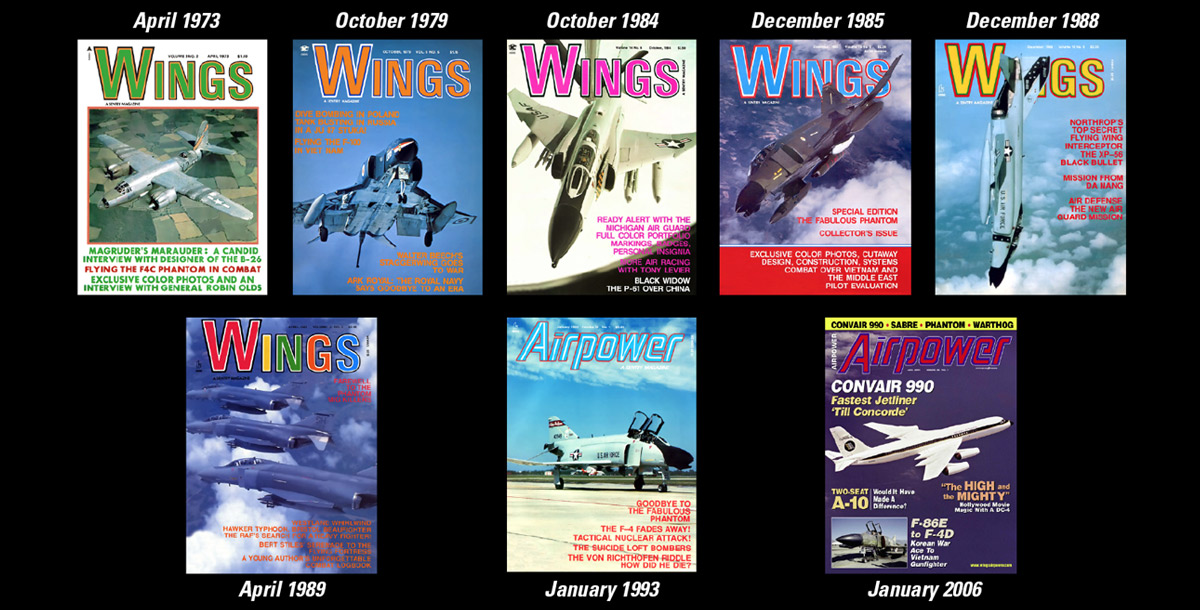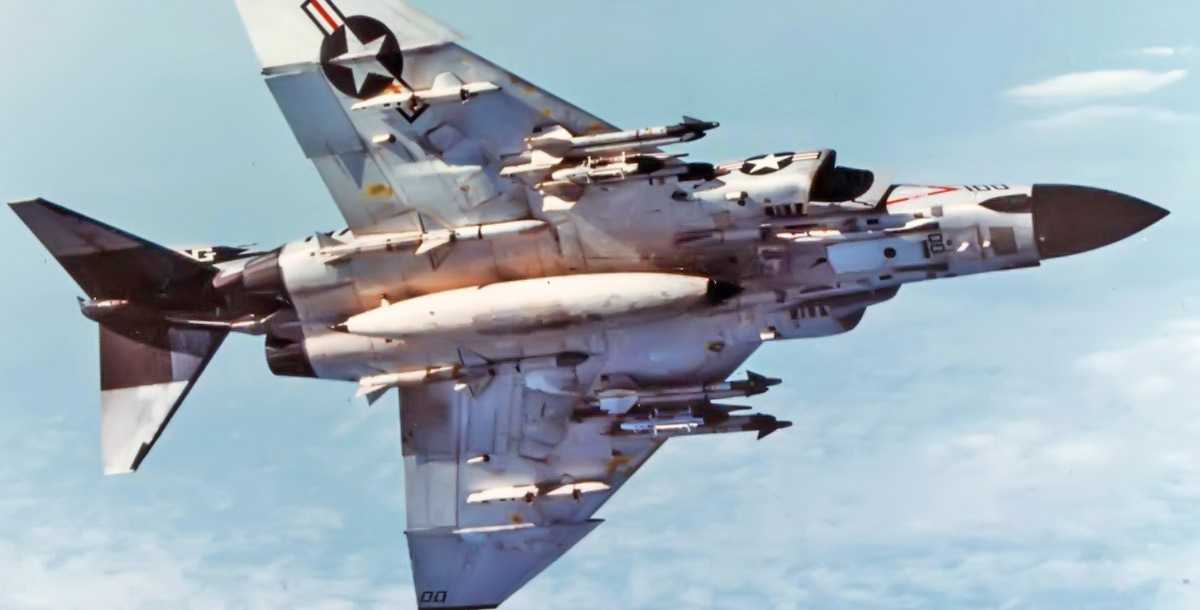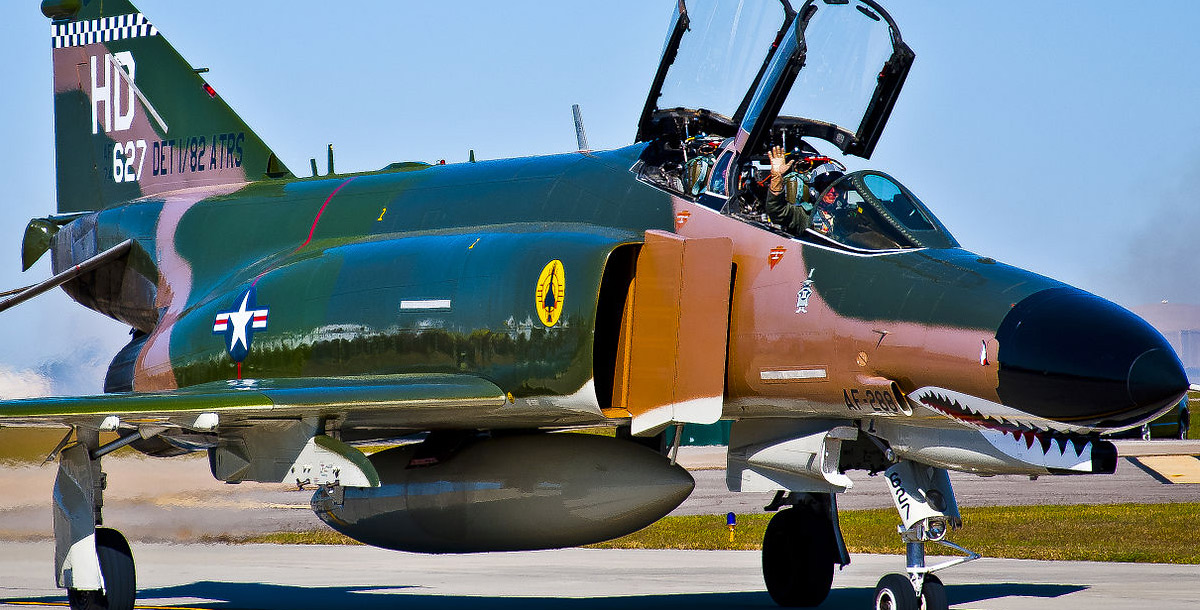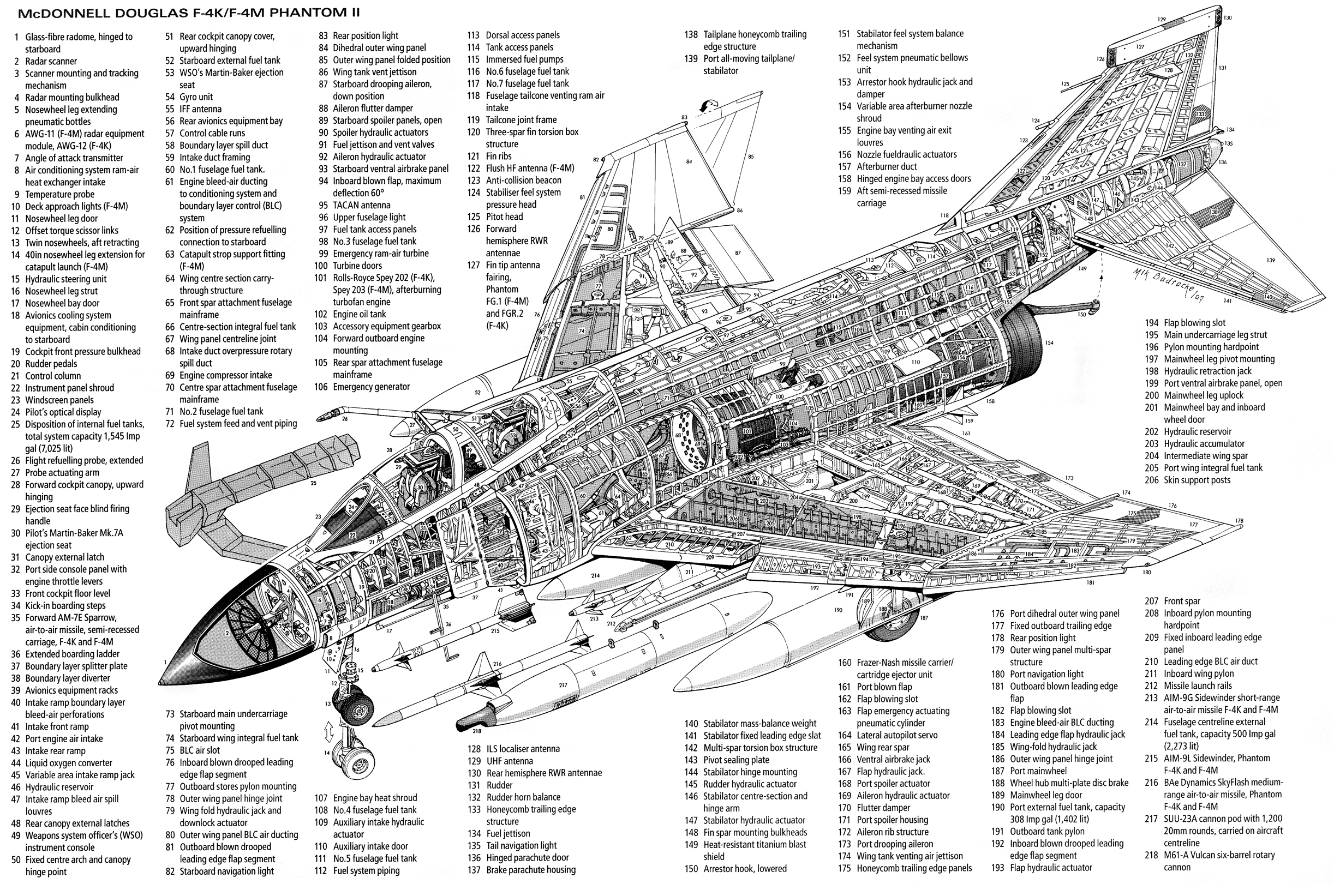Price: $39.95
- 8 magazines, 12 documents, & photos
- PDF contains 4,259 pages
- Content is keyword searchable
- Print a personal copy
- Pay via PayPal or Credit Card
- International orders welcome!
- Download files upon payment
April 1973
- Combat Flying the F-4 Phantom
- Good Vibrations, flight training in the BT-13 circa 1943
- King-Sized P-51 Mustang
- Magruder’s Marauder, interview the designer of the B-26
- Martin’s Torpedo Trucks
October 1979
- F-4 Phantom on the last of England’s fixed-wing aircraft carriers
- Blitzkrieg, tank-busting Ju-87 Stuka
- Super Sabre, conclusion of classic fighter/bomber story
- Staggerwing, Wichita’s wondrous warbird
October 1984
- Phantom Alert, the 191st Michigan Fighter Intercept Group
- Terror in the Dark, the Northrop P-61 Black Widow over China
- Sky King, air racing with the Menisci Buccaneer
December 1985
- The Fabulous Phantom, a complete look at the most important fighter-bomber in recent aviation history
December 1988
- Guardians of the Blue, we fly long range air defense mission in F-4 with Minnesota Air National Guard
- Odyssey at Da Nang, story of great American base in Southeast Asia
- Black Bullet, Northrop’s mysterious secret fighter
April 1989
- The MiG-Killers Last Hurrah! F-4 Phantoms pose for the last time in US colors
- Serenade, the story of Bert Stiles, B-17 & P-51 pilot
- Weathering the Storm, WWII Whirlwind, Beaufighter, and Typhoon
January 1993
- Phantom Farewell, after 30 years the F-4 says goodbye
- Toss Bombing, ground attack nuclear style
- The Von Richthofen Riddle, the Red Baron’s last hours
January 2006
- From Jet Ace to Gunfighter, Cecil G. Foster, F-86 Sabre ace to F-4 Phantom pilot in the skies above the Ho Chi Minh Trail
- The Maserati of Jets, the Convair 990
- Two-seat A-10 Thunderbolt II
- The High and the Mighty, working with John Wayne and Douglas DC-4 in classic movie
Manuals & Photos
- F-4C/D/E Flight Manual, 1970
- F-4E Flight Handbook, 1979
- F-4J NATOPS Flight Manual, 1975
- RF-4B NATOPS Flight Manual, 1965
- F-4 Phantom Guide USAF, 1988
- F-4 Phantom Mk1 Aircrew Manual, 1969
- F-4 Phantom Mk2 Aircrew Manual, 1990
- F-4E Thunderbird Configuration, 1969
- F-4 Accident Handbook, 1967
- F-4 Crew Chief Handbook, 1975
- F-4C Powerplant Maintenance, 1978
- BONUS! The F-4 Plane Captain’s Handbook from the McDonnell Aircraft Corporation, 1964, 82 pages
- Over 300 F-4 Phantom II photos
McDonnell Douglas F-4 Phantom II
F-4E Specs
Variants
On Display
Cutaway
Videos
General Characteristics
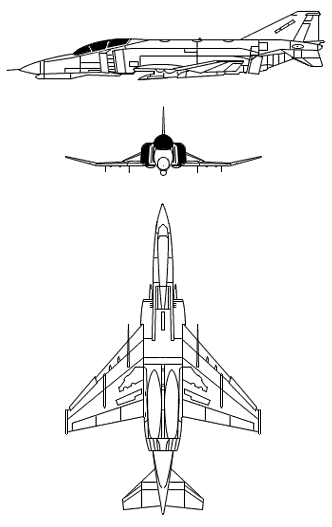
- Crew: 2
- Length: 63 ft 0 in (19.2 m)
- Wingspan: 38 ft 4.5 in (11.7 m)
- Height: 16 ft 6 in (5.0 m)
- Wing area: 530.0 ft² (49.2 m²)
- Airfoil: NACA 0006.4–64 root, NACA 0003-64 tip
- Empty weight: 30,328 lb (13,757 kg)
- Loaded weight: 41,500 lb (18,825 kg)
- Max. takeoff weight: 61,795 lb (28,030 kg)
- Powerplant: 2 × General Electric J79-GE-17A axial compressor turbojets, 11,905 lbf dry thrust (52.9 kN), 17,845 lbf in afterburner (79.4 kN) each
- Zero-lift drag coefficient: 0.0224
- Drag area: 11.87 ft² (1.10 m²)
- Aspect ratio: 2.77
- Fuel capacity: 1,994 U.S. gal (7,549 L) internal, 3,335 U.S. gal (12,627 L) with three external tanks (370 U.S. gal (1,420 L) tanks on the outer wing hardpoints and either a 600 or 610 U.S. gal (2,310 or 2,345 L) tank for the centerline station).
- Maximum landing weight: 36,831 lb (16,706 kg)
Performance
- Maximum speed: Mach 2.23 (1,472 mph, 2,370 km/h) at 40,000 ft (12,190 m)
- Cruise speed: 506 kn (585 mph, 940 km/h)
- Combat radius: 367 nmi (422 mi, 680 km)
- Ferry range: 1,403 nmi (1,615 mi, 2,600 km) with 3 external fuel tanks
- Service ceiling: 60,000 ft (18,300 m)
- Rate of climb: 41,300 ft/min (210 m/s)
- Wing loading: 78 lb/ft² (383 kg/m²)
- lift-to-drag: 8.58
- Thrust/weight: 0.86 at loaded weight, 0.58 at MTOW
- Takeoff roll: 4,490 ft (1,370 m) at 53,814 lb (24,410 kg)
- Landing roll: 3,680 ft (1,120 m) at 36,831 lb (16,706 kg)
Armament
- Up to 18,650 lb (8,480 kg) of weapons on nine external hardpoints, including general purpose bombs, cluster bombs, TV- and laser-guided bombs, rocket pods, air-to-ground missiles, anti-ship missiles, gun pods, and nuclear weapons. Reconnaissance, targeting, electronic countermeasures and baggage pods, and external fuel tanks may also be carried.
- 4× AIM-7 Sparrow in fuselage recesses plus 4 × AIM-9 Sidewinders on wing pylons; upgraded Hellenic F-4E and German F-4F ICE carry AIM-120 AMRAAM, Japanese F-4EJ Kai carry AAM-3, UK Phantoms carried Skyflash missiles
- 1× 20 mm (0.787 in) M61A1 Vulcan 6-barrel Gatling cannon, 640 rounds
- 4× AIM-9 Sidewinder, Python-3 (F-4 Kurnass 2000)
- 4× AIM-7 Sparrow, AAM-3(F-4EJ Kai)
- 4× AIM-120 AMRAAM for F-4F ICE, F-4E AUP (Hellenic Air Force)
- 6× AGM-65 Maverick
- 4× AGM-62 Walleye
- 4× AGM-45 Shrike, AGM-88 HARM, AGM-78 Standard ARM
- 4× GBU-15
- 18× Mk.82, GBU-12
- 5× Mk.84, GBU-10, GBU-14
- 18× CBU-87, CBU-89, CBU-58
- Nuclear weapons, including the B28EX, B61, B43 and B57
- XF4H-1
- Two prototypes for the United States Navy, first flown 1958.
- F4H-1F (F-4A)
- Two-seat all-weather carrier-based fighter for the US Navy, J79-GE-2 and -2A engines with 16,100 lbf (71.6 kN) of afterburner thrust each. Named Phantom II in 1959 and redesignated F-4A in 1962; 45 built.
- TF-4A
- A small number of F-4As converted into two-seat training aircraft.
- F4H-1 (F-4B)
- Two-seat all-weather carrier-based fighter and ground-attack aircraft for the US Navy and Marine Corps. J79-GE-8A or -8B engines with 16,950 lbf (75.4 kN) of afterburner thrust each. Redesignated F-4B in 1962; 649 built.
- DF-4B
- F-4Bs converted into drone control aircraft.
- EF-4B
- One F-4B converted into an ECM training aircraft.
- NF-4B
- The redesignation of one F-4B for testing purposes.
- QF-4B
- F-4Bs converted into unmanned supersonic target drones; 25 converted.
- F4H-1P (RF-4B)
- Tactical reconnaissance version of F-4B for United States Marine Corps, nose stretched 4 ft 9 in (1.4 m), smaller AN/APQ-99 radar. Three camera bays typically carried KS-87 forward oblique/vertical camera on Station 1, KA-87 low-altitude camera on Station 2, and KA-55A or KA-91 high-altitude panoramic camera on Station 3. Also carried AN/APQ-102 reconnaissance SLAR, AN/AAD-4 infrared reconnaissance system, and ALQ-126 ECM suite. The KS-72 or KS-85 cameras were on rotating mounts and could be aimed in flight which improved upon the earlier RF-4C which could only be aligned on the ground. In 1975, modernized under Project SURE(Sensor Update and Refurbishment Effort); 46 built. Retired in 1990. 4 lost in Vietnam. First flown 12 March 1965.
- F-110A Spectre
- The original US Air Force designation for the F-4C.
- F-4C
- Two-seat all-weather tactical fighter, ground-attack version for the United States Air Force; supported a wide spectrum of weapons including AIM-4 Falcon, AGM-12 Bullpup, and nuclear weapons; wider main wheel tires resulted in distinctive wing bulges; J79-GE-15 engines with provision for cartridge start; boom refueling instead of Navy’s probe and drogue refueling; AN/APQ-100 radar; duplicated flight controls in the rear cockpit. The aircraft exceeded Mach 2 during its first flight on 27 May 1963; 583 built.
- EF-4C Wild Weasel IV
- F-4Cs converted into Wild Weasel ECM aircraft. Equipped with AN/APR-25 RHAWS, AN/APR-26 missile launch warning system, ER-142 ECM receiver, and AN/ALQ-119 external ECM pod. Armed with AGM-45 Shrike anti-radiation missiles and cluster bombs but unable to carry the AGM-78 Standard ARM missile. A total of 36 were converted. Many survivors were reverted to F-4C.
- RF-4C
- All-weather tactical reconnaissance version for the US Air Force, AN/APQ-99 (later AN/APQ-172) radar. Equipped similar to RF-4B but with a wider choice of camera fits, including a centerline pod for the gigantic HIAC-1 LOROP (Long Range Oblique Photography) camera, capable of taking high-resolution images of objects 100 miles (160 km) away. Many aircraft were refitted with a more spacious bulging streamlined nose. A sub-variant, to be designated RF-4C(H) was proposed as a night “hunter” aircraft using infrared equipment instead of cameras under Operation Shed Light. In the end, none were converted. While usually unarmed, RF-4Cs retained the ability to carry a nuclear weapon on the centerline pylon. Additionally, the RF-4Cs of the Alabama, Nevada and RF-4 Fighter Weapons School were modified to carry the AIM-9 Air to Air Missile. These modernized RF-4Cs of the Alabama and Nevada Air National Guard extensively participated in the Gulf War; 503 built.
- Two RF-4Cs shot down by USSR during Project Dark Gene whilst being flown by USAF pilots.
- YRF-110A (YRF-4C)
- Two prototypes were used in the development of the RF-4C reconnaissance version.
- F-4D
- F-4C with updated avionics, AN/APQ-109 radar. First flight June 1965. One USAF pilot and two USAF WSOs (later retrained as pilots) became aces in F-4Ds; 825 built.
- EF-4D Wild Weasel IV
- F-4Ds converted into Wild Weasel ECM aircraft. Unlike the EF-4C, the EF-4D had the capability to use the larger AGM-78 Standard ARM. Only 2 converted.
- F-4E
- USAF version with an integral M61 Vulcan cannon in the elongated RF-4C nose, AN/APQ-120 radar with smaller cross-section to accommodate the cannon, J79-GE-17 engines with 17,900 lbf (79.379 kN) of afterburner thrust each. Late-series aircraft equipped with leading-edge slats to improve maneuverability at the expense of top speed under the Agile Eagle program. Starting with Block 53, aircraft added AGM-65 Maverick capability and smokeless J79-GE-17C or -17E engines. First flight 1 August 1965. The most numerous Phantom variant; 1,370 built.
- F-4E Kurnass 2000
- Modernized Israeli F-4Es, AN/APG-76 radar, AGM-142 Popeye capability.
- F-4E Peace Icarus 2000
- Hellenic Air Force modernized F-4Es, AN/APG-65GY radar, AIM-120 AMRAAM capability, Litening targeting pod, modern A/G weapons capability.
- F-4 Terminator 2020
- The latest in a long line of F-4 variants, the Terminators are a batch of Turkish Air Force F-4Es, modernized by Israel. They differ from the existing F-4E airframe in a number of key areas: small strakes have been fitted above the air intakes to improve the agility of the fighter, and new attachment fittings have also been added to better handle modern weaponry. Other additions include stronger wing fold ribs, an updated canopy sill bar, and the replacement of some 20 km of wiring (reducing weight by 750 kg) as well as most hydraulic and pneumatic lines and hoses.
- The most radical changes occurred in the avionics department. All 2020s have been fitted with vastly updated suite, including MFDs (multifunction displays) as standard, and incorporating a number of new technologies, such as the new Kaiser El-OP 976 wide-angle HUD and HOTASsystem, high performance Elta EL/M-2032 ISAR-capable high-resolution SAR/GMTI (ground moving target indicator) multi-mode fire control radar (developed for the IAI Lavi), IAIC mission computer, new navigation equipment including GPS/INS connected to mapping mode, dual MIL-STD-553B databus managing avionics package, Astronautics Central Air Data Computer, new UHF and IFF packages, airborne video tape recorder (AVTR), Elta EL/L-8222 active ECMpod, Mikes (Aselsan) AN/ALQ-178V3 passive embedded SPEWS, and RWR.
- Additionally, they received AGM-142 Popeye/Have Nap integration, Litening-II targeting pods, and the capability to launch AGM-65D/G Maverick, AGM-88 HARM, GBU-8 HOBOS, GBU-10/12 Paveway II LGBs, general purpose and cluster bombs for air-to-ground missions, while retaining the capability to launch AIM-7 Sparrow and AIM-9 Sidewinder air-to-air missiles. It is also possible to install Pave Spike targeting pods and rocket pods of all sizes.
- These upgraded F-4 Phantoms are referred to as the F-4E-2020 Terminator. They will be in service until at least 2015 and perhaps longer. They first entered service on 27 January 2000 with deliveries to 111 and 171 Filo.
- QF-4E
- Remote-controlled target drone.
- F-4EJ
- Two-seat all-weather air defense fighter version of F-4E, initially lacked ground attack capability. Built under licence in Japan, by Mitsubishi Heavy Industries for the Japan Air Self-Defense Force; 140 built (138 by Mitsubishi).
- F-4EJ Kai
- Upgraded version of the F-4EJ with improved avionics, including AN/APG-66J pulse-doppler radar, and ground attack capability, including ASM-1 anti-ship missile.
- EF-4EJ
- Small number of F-4EJs were converted into ECM training aircraft.
- F-4E(S)
- Three Israeli F-4E modified for high-speed reconnaissance as a cheaper alternative to the ambitious F-4X. Fitted with a new nose containing the HIAC-1 LOROP long-range camera with a 66-in (168 cm) focal length as well as a vertical KS-87 camera. The aircraft had a false radome painted on the nose to resemble conventional F-4Es. The fate and service record of these aircraft is unknown.
- RF-4E
- Unarmed reconnaissance version for export only. Retrofitted to carry weapons by most customers. Several German Air Force aircraft were modified for ELINT missions under Peace Trout program; 149 built.
- RF-4EJ
- Two-seat all-weather tactical reconnaissance version for the Japanese Air Self-Defense Force; 14 built.
- RF-4EJ Kai
- Upgraded version of the RF-4EJ with improved avionics, AN/APG-66J radar.
- YF-4E
- One of the original YRF-4C prototypes was converted into the YF-4E. The YF-4E was used in the development of the F-4E fighter as well as in fly-by-wire Precision Aircraft Control Technology (PACT) and Control Configured Vehicle (CCV) test programs. Three conversions.
- F-4F
- F-4E for German Air Force with simplified equipment, no Sparrow capability; 175 built.
- F-4F ICE
- Upgraded F-4F with AN/APG-65 radar and AIM-120 AMRAAM capability.
- TF-4F
- German trainer aircraft, with pilot instructor aft station and appropriate controls.
- F-4G
- US Navy version, 12 F-4Bs were fitted with the AN/ASW-21 data link digital communications system for automatic carrier landings, one shot down by enemy ground fire, the surviving 11 returned to F-4B configuration.
- F-4G Wild Weasel V
- F-4E converted to SEAD aircraft for the US Air Force. AN/APQ-120 radar, their cannon replaced by the APR-38 RHAW[15] and later the AN/APR-47,[16] several ECM pods including the ALQ-87, ALQ-101, ALQ-119, ALQ-130, ALQ-131, and the ALQ-140 IR jammer, the ability to carry AGM-45 Shrike, AGM-78 Standard, and AGM-88 HARM anti-radiation missiles. Widely used during the Gulf War, Operation Provide Comfort, and Operation Southern Watch; 116 converted initially, with a further 18 F-4E’s converted as attrition replacements for a total of 134.
- QF-4G
- Remote-controlled target drone.
- F-4H
- Designation not used to avoid confusion with the pre-1962 F4H.
- F-4J
- Improved F-4B version for US Navy and Marine Corps, with emphasis on air-to-air combat capability improvement, which include: J79-GE-10 engines with 17,844 lbf (79.374 kN) of afterburner thrust each, AN/APG-59 pulse doppler radar coupled with the AN/AWG-10 Fire Control System for look-down shoot-down capability, larger main landing gear wheels resulting in wing bulges similar to F-4C, slatted tailplane, ailerons drooped 16.5° when landing gear and flaps were deployed to decrease the landing speed, zero-zero ejection seats, expanded ground attack capability, no IRST sensor under the nose; One USN pilot and one USN Naval Flight Officer became aces in F-4Js. First flight May 1966; 522 built.
- F-4J(UK)
- Designation of 15 low airtime F-4J aircraft purchased by the Royal Air Force from the US Navy in 1984, upgraded to F-4S standard with some British equipment. Used until 1991 by No. 74 Squadron RAF only for UK air defense in lieu of Phantoms sent to Falklands.
- DF-4J
- One F-4J converted into a drone control aircraft.
- EF-4J
- Two F-4Js converted into ECM training aircraft.
- YF-4J
- Three F-4Bs were converted were into YF-4J prototypes. The YF-4Js were used in the development of the F-4J.
- F-4K
- F-4J version for Fleet Air Arm of the Royal Navy to replace the De Havilland Sea Vixen.[18] Operated as the Phantom FG1 (Fighter/Ground attack). Folding nose and extending nosewheel leg. Re-engined with the more powerful British Rolls-Royce Spey 202 turbofan engines which required an enlarged fuselage but gave more power taking off from smaller carriers and was already in use with Blackburn Buccaneer on RN carriers. Delivered from 1968, with cancellation of planned carriers order cut and 20 diverted to the Royal Air Force before going into service; 50 built. RN aircraft withdrawn by 1978 and passed to RAF.
- YF-4K
- Two prototypes, used in the development of the F-4K.
- F-4L
- Designation applied to several proposals for an advanced version, including Model 98FOA with RR Spey turbofan engines and AIM-54 Phoenix missiles.
- F-4M
- Tactical fighter, ground-attack, and reconnaissance aircraft developed from F-4K for the Royal Air Force, RAF designation Phantom FGR.Mk.2, ordered after cancellation of the Hawker Siddeley P.1154 supersonic V/STOL aircraft. RR Spey turbofan engines; 116 built. Replaced English Electric Canberra and Hawker Hunter. Replaced in turn by SEPECAT Jaguar in ground-attack mission; replaced English Electric Lightning in air defense role.
- YF-4M
- Two prototypes used in the development of the F-4M.
- F-4N
- F-4B modernized under project Bee Line, the same aerodynamic improvements as F-4J, smokeless engines. First flight 4 June 1972; 228 converted.
- QF-4N
- F-4Ns converted into remote-controlled supersonic target drones.
- F-4S
- F-4J modernized with smokeless engines, reinforced airframe, leading-edge slats for improved maneuverability. First flight July 1977; 302 converted.
- QF-4S
- F-4S converted into supersonic target drones.
- F-4E/TM
- Latest modern F-4E variant available. Modernised by ASELSAN for the Turkish Air Force.
- RF-4E/TM
- Latest modern RF-4E variant available. Modernised by ASELSAN for the Turkish Air Force.
Proposals
- F-4E(F)
- Proposed single-seat simplified version of F-4E for the German Air Force; none built.
- F-4T
- Proposed air superiority-only fighter version; none built.
- F-4VG
- Proposed version with variable geometry wings; none built.
- F-4X
- Proposed high-performance reconnaissance version with HIAC-1 LOROP camera for Israel developed under the Peace Jack program in conjunction with General Dynamics. Water injection was projected to give the aircraft a top speed in excess of Mach 3 (over 2,000 mph (3,200 km/h) at high altitudes). The water would be contained in a pair of 2,500 US gal (9,600 l) conformal tanks on the sides of the fuselage spine. The US State Department became worried about developing an aircraft with performance similar to the SR-71 Blackbird and offensive capability beyond anything in domestic inventory for a foreign customer and forbade its export. The proposal was then modified to the RF-4X standard with the camera in the nose and removal of weapon carriage. However, the US Air Force withdrew from the project over concerns that a high-performance Phantom would jeopardize funding for the anticipated McDonnell Douglas F-15 Eagle. Without United States financial support, Israel settled for the simpler, less expensive F-4E(S), which was given the nickname ‘Shablool’, or ‘Snail’.
- Boeing Super Phantom
- A 1984 joint venture between Boeing and Pratt & Whitney for a Phantom variant with Pratt & Whitney PW1120 turbofan engines, giving a significant performance gain over J79 Phantoms. The aircraft would also have an 1,100 US gal (4,230 L) conformal fuel tank under the fuselage. Cancelled early in development.
- IAI Super Phantom
- A separate Israel Aircraft Industries project was proposed for a PW1120-powered Phantom, and one prototype built. IAI’s F-4 “Super Phantom” or F-4-2000, which could exceed Mach 1 without afterburners, was displayed at the 1987 Paris Air Show. McDonnell Douglas scuttled the F-4-2000’s development because it equaled the F/A-18C/D in performance and could endanger future F/A-18 sales.
Australia
-
- F-4E
- 67-0237 – RAAF Museum, Melbourne. An ex-USAF F-4E painted to represent one of the examples flown by the RAAF while awaiting delivery of the F-111.
Belgium
-
- RF-4C
- 68-0590 – Royal De L’Armee Museum, Brussels.
Chile
-
- F-4C-21
- 37683 – Museo Aeronáutico y del Espacio, Santiago. December 31, 1964: first deployed to the 8th TFW GAFB, California; assigned to the 431st TFS. February 4, 1967: assigned to the 366th TFW, Southeast Asia. January 15, 1968: assigned to the 347th TFW. January 12, 1970: transferred to 4452d CCTS, GAFB, CA. April 5, 1972: assigned to the 183d TFG. December 10, 1980: assigned to the 142 CAM Sq, Oregon ANG. March 30, 1995. received in Chile for static display and repainted in SE Asia colors.
Guam
-
- F-4E
- 1392 – Andersen Air Force Base. F-4E, serial number 71-1392, tailcode “PN” is currently on display at Anderson AFB. 3d Tactical Fighter Wing, 3rd Tactical Fighter Squadron of the Thirteenth Air Force while stationed at Clark Air Base
Germany
-
- RF-4E
- 35+62 – Luftwaffe-Museum, Berlin. Former LuftwaffeRF-4E Phantom II
-
- F-4F
- 38+04 – Luftwaffe-Museum, Berlin. Former LuftwaffeF-4F Phantom II.
- 38+34 – Luftwaffe-Museum, Berlin. Former LuftwaffeF-4F Phantom II.
Turkey
-
- F-4E
- 67-0360 – Istanbul Aviation Museum, Istanbul. Retired Turkish Air Force Phantom II with engines removed.
United Kingdom
-
- F-4C
- 63-7699 – Midland Air Museum, Coventry.
-
- F-4J(UK)
- 155529 – Imperial War Museum, Duxford.
-
- F-4S
- 155848 – National Museum of Flight, East Fortune.
-
- FG.1
- XT596 – Fleet Air Arm Museum, Yeovilton.
-
- FGR.2
- XV406 – Solway Aviation Museum, Carlisle.
- XV474 – Imperial War Museum, Duxford.
United States
- Airworthy
-
- F-4D
- 65-0749 – Collings Foundation, Stow, Massachusetts. Painted in markings of MiG killer F-4D aircraft, AF Ser. No. 66-7463, while assigned to the 555th Tactical Fighter Squadron, circa 1972.[14]
- Multiple QF-4C, QRF-4C and QF-4E aircraft remain in operation by the 82d Aerial Targets Squadron (82 ATRS) at Tyndall AFB, Florida and the 82 ATRS Detachment 1 at Holloman AFB, New Mexico under the U.S. Air Force’s Full Scale Aerial Targets (FSAT) Program. Most aircraft have been modified under Not Under Live Local Operation (NULLO) standards and have had ejection seats removed for eventual expenditure as aerial targets. However, several F-4Es are used almost exclusively for USAF “Heritage Flight” aerial demonstrations and retain ejection seats and cockpit flight controls.
- On display
-
- F-4A (F4H-1F)
- 145315 – USS Lexington Museum, Corpus Christi, Texas.
- 148261 – NAS Oceana Air Park, Naval Air Station Oceana, Virginia.
- 148275 – US Naval Academy, Annapolis, Maryland (last F-4A-4-MC Phantom II).
-
- F-4B (F4H-1)
- 148412 – Heritage In Flight Museum, Lincoln, Illinois.
- 148400 – Hickory Regional Airport, North Carolina.
- 152986 – Wedell-Williams Aviation Museum, Patterson, Louisiana.
- 153019 – Naval Air Station Key West, Florida
-
- RF-4B
- 151981 – Flying Leatherneck Historical Foundation and Aviation Museum, Marine Corps Air Station Miramar, California.
- 157342 – Marine Corps Air Station Cherry Point, North Carolina.
- 157349 – National Naval Aviation Museum, Naval Air Station Pensacola, Florida.
-
- F-4C
- 63-7408 – Tyndall Air Force Base, Panama City, Florida.
- 63-7415 – Texas Air Museum, Stinson Municipal Airport, San Antonio, Texas.
- 63-7424 – Hill Aerospace Museum, Hill Air Force Base, Utah.
- 63-7482 – Minnesota ANG Museum, Minneapolis-Saint Paul Joint Air Reserve Station, St. Paul, Minnesota.
- 63-7485 – Museum of Aviation, Robins Air Force Base, Warner Robins, Georgia.
- 63-7534 – Selfridge Air National Guard Base, Michigan.
- 63-7535 – Holloman Air Force Base, New Mexico.
- 63-7555 – Yankee Air Museum, Belleville, Michigan.
- 63-7693 – March Field Air Museum, March Air Reserve Base, Riverside, California.
- 63-7704 – Milwaukee Airport, Wisconsin.
- 64-0664 – Hill Aerospace Museum, Hill Air Force Base, Utah.
- 64-0673 – Pima Air & Space Museum (adjacent to Davis-Monthan Air Force Base), Tucson, Arizona.
- 64-0741 – Flight Systems Inc, Mojave, California.
- 64-0748 – Langley Air Force Base, Virginia.
- 64-0770 – Seymour Johnson Air Force Base, Goldsboro, North Carolina.
- 64-0776 – Museum of Flight, Seattle, Washington.
- 64-0783 – Grissom Air Museum, Grissom Air Reserve Base, Peru, Indiana.
- 64-0799 – Peterson Air and Space Museum, Peterson Air Force Base, Colorado Springs, Colorado (presented as 63-7589 of the 57th FIS at NAS Keflavik, Iceland, ca. 1978).
- 64-0806 – Nellis Air Force Base, Nevada.
- 64-0813 – Air Force Armament Museum, Eglin Air Force Base, Florida.
- 64-0815 – Mighty Eighth Air Force Museum, Pooler, Georgia.
- 64-0825 – Fort Worth Aviation Museum, Fort Worth, Texas.
- 64-0829 – National Museum of the United States Air Force, Wright-Patterson Air Force Base, Ohio.
-
- RF-4C
- 63-7745 – Birmingham Air National Guard Base, Birmingham, Alabama.
- 63-7746 – March Field Air Museum, March Air Reserve Base, Riverside, California.
- 63-7748 – Shaw Air Force Base, South Carolina.
- 64-0748 – Langley Air Force Base, Virginia.
- 64-0998 – Lincoln Air National Guard Base, Lincoln, Nebraska.
- 64-1000 – Rusty Allen Airport, Lago Vista, Texas.
- 64-1047 – National Museum of the United States Air Force, Wright-Patterson Air Force Base, Ohio.
- 64-1061 – Minnesota ANG Museum, Minneapolis-Saint Paul Joint Air Reserve Station, St. Paul, Minnesota.
- 65-0903 – Strategic Air and Space Museum, Ashland, Nebraska.
- 65-0905 – Hill Aerospace Museum, Hill Air Force Base, Utah.
- 66-0469 – Hill Aerospace Museum, Hill Air Force Base, Utah.
- 67-0452 – Air Force Armament Museum, Eglin Air Force Base, Florida
- 69-0372 – Air Power Park and Museum, Hampton, Virginia.
-
- YRF-4C
- 62-12201 – Octave Chanute Aerospace Museum (former Chanute Air Force Base), Rantoul, Illinois.
-
- F-4D
- 64-0965 – Van Zandt County Veteran’s Memorial, Canton, Texas.
- 65-0626 – Empire State Aerosciences Museum, Glenville, New York.
- 65-0747 – Colonel Joe Kittinger Park at Orlando Executive Airport. Previously on display at Navarro College, Corsicana, Texas.Relocated to Orlando Executive Airport, Florida on 22 Jul 2014 for restoration in Vietnam-era 555th Tactical Fighter Squadron paint scheme.
- 65-0796 – William E. Dyess Elementary School, adjacent to Dyess Air Force Base, Abilene, Texas.
- 66-0267 – Homestead Air Reserve Base, Florida.
- 66-0269 – New England Air Museum, Windsor Locks, Connecticut.
- 66-0273 – Homestead, Florida; highway median of U.S. 1, just north of 304th Street. Maintenance responsibility remains with 482d Fighter Wing at nearby Homestead ARB.
- 66-7463 – Cadet Area Quadrangle, U.S. Air Force Academy, Colorado. Multiple North Vietnamese Air Force MiG kills by this aircraft while assigned to the 555th Tactical Fighter Squadron during the Vietnam War, including several by USAF fighter aces, retired Brig Gen Steve Ritchie and retired Col Chuck DeBellevue.
- 66-7468 – 183d Fighter Wing, Capital Airport Air National Guard Station, Springfield, Illinois.
- 66-7518 – Charles B. Hall Airpark, Tinker Air Force Base, Oklahoma.
- 66-7554 – Museum of Aviation, Robins Air Force Base, Warner Robins, Georgia.
- 66-8711 – Hill Aerospace Museum, Hill Air Force Base, Utah.
- 66-8755 – Freedom Hill Amphitheatre, Sterling Heights, Michigan.
- 66-8812 – Historic Aviation Memorial Museum, Tyler, Texas.
-
- F-4E
- 66-0284 – Burke Lakefront Airport, Cleveland, Ohio.
- 66-0289 – Castle Air Museum (former Castle Air Force Base), Atwater, California.
- 66-0315 – Monett, Missouri.
- 66-0329 – Pima Air & Space Museum (adjacent to Davis-Monthan Air Force Base), Tucson, Arizona.
- 67-0327 – Luke Air Force Base, Arizona.
- 67-0392 – Virginia Air & Space Center, Hampton, Virginia.
- 68-0304 – Hill Aerospace Museum, Hill Air Force Base, Utah.
- 68-0337 – AMARC “Celebrity Row,” Davis-Monthan Air Force Base, Arizona. Five (5) MiG kills ascribed to this aircraft during the Vietnam War.
- 68-0382 – March Field Air Museum, March Air Reserve Base, Riverside, California.
- 74-0649 – Seymour Johnson Air Force Base, Goldsboro, North Carolina.
-
- YF-4E
- 62-12200 – National Museum of the United States Air Force, Wright-Patterson Air Force Base, Ohio.
-
- F-4J
- 153071 – Patuxent River Naval Air Museum, Naval Air Station Patuxent River, Lexington Park, Maryland.
- 153074 – NAS Lakehurst Air Park, Naval Air Engineering Station Lakehurst, New Jersey.
- 153077 – Patriots Point Naval & Maritime Museum, USS Yorktown (CV-10), Charleston, South Carolina.
- 153088 – American Legion Post #38, Baton Rouge, Louisiana.
- 153812 – Burke Lakefront Airport, Cleveland, Ohio.
- 153889 – MCAS Kaneohe Bay / Marine Corps Base Hawaii (formerly Marine Corps Air Station Kaneohe Bay, Kaneohe, Hawaii.
- 155563 – Valiant Air Command Warbird Museum, Space Coast Regional Airport, Titusville, Florida.
-
- YF-4J
- 151497 – Pima Air & Space Museum (adjacent to Davis-Monthan Air Force Base), Tucson, Arizona.
-
- F-4N
- 150444 – Prairie Aviation Museum, Bloomington, Illinois.
- 150639 – Warrior Park, Davis-Monthan Air Force Base, Arizona. Painted to look like a USAF F-4C with tail number 64-0639.
- 152270 – Marine Corps Air Station Beaufort, South Carolina.
- 152996 – Southern Museum of Flight, Birmingham, Alabama.
- 153016 – Commemorative Air Force/Arizona Wing, Mesa, Arizona.
- 153030 – San Diego Aircraft Carrier Museum, USS Midway (CV-41), San Diego, California.
- 153915 – National Naval Aviation Museum, Naval Air Station Pensacola, Florida.
-
- F-4S
- 153821 – Fort Worth Aviation Museum, Fort Worth, Texas.
- 153880 – San Diego Aircraft Carrier Museum, USS Midway (CV-41), San Diego, California.
- 155764 – MAPS Air Museum, Canton, Ohio.
- 155872 – Carolinas Aviation Museum, Charlotte Douglas International Airport, Charlotte, North Carolina.
- 157246 – Flying Leatherneck Aviation Museum, Marine Corps Air Station Miramar, California.
- 157259 – Point Mugu Missile Park, Naval Air Station Point Mugu, California.
- 157267 – San Diego Aerospace Museum, San Diego, California.
- 157307 – National Air & Space Museum, Washington D.C..


